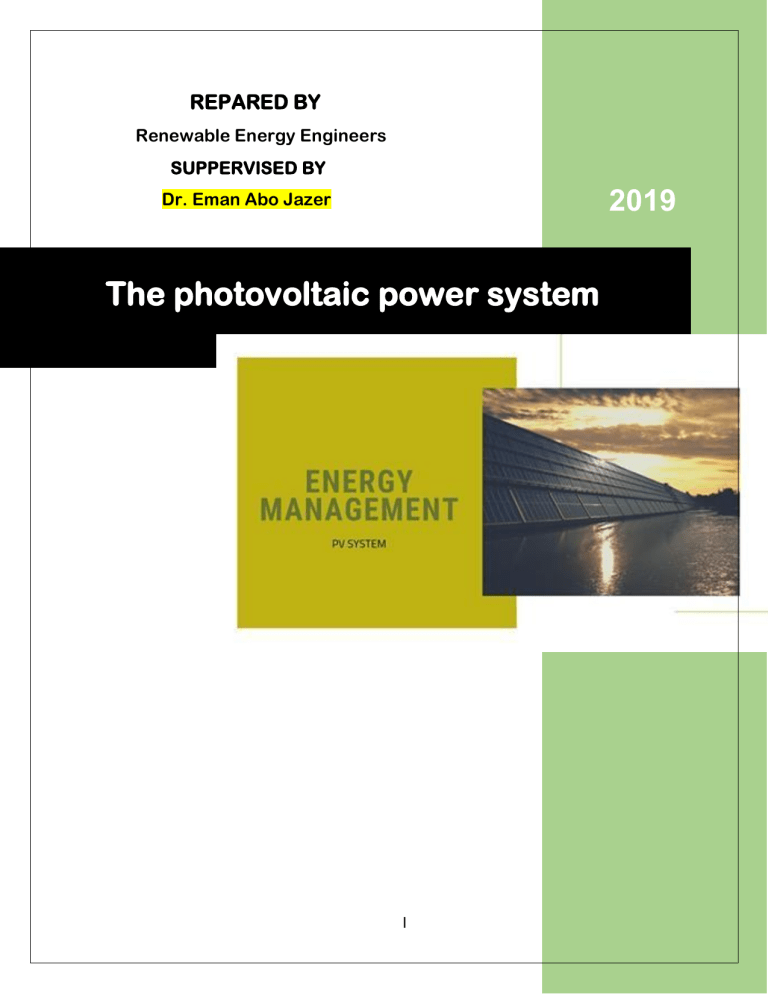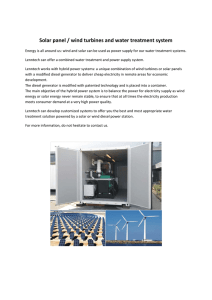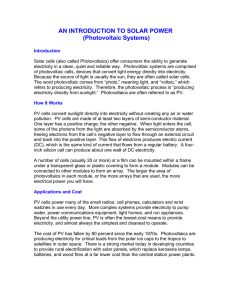
REPARED BY Renewable Energy Engineers SUPPERVISED BY Dr. Eman Abo Jazer 2019 The photovoltaic power system I Acknowledgement To Allah, we firstly admit all our praise and thanks for his gracing and giving which enabled us to finish this work as perfect as it is. We also send our pleasing and peace upon his prophet Mohammed the mercy and teacher for the mankind. Our thanks continued to our parents for their effort and care, to our lecturers for their support and instructions, to friends and all those who helped us to end this work. we wish to express our deepest appreciation to our college, thanks to all our doctors and teachers, special thanks for Dr : Eman Abu Gazar . II Abstract In this research, a study was conducted to install the photovoltaic power system with batteries for the Bahlol gas station - Gaza to connect the gas station with a power instead of using diesel due to continuous power cuts and cost reduction and carbon CO2 emissions. The research involved studying the location and intensity of solar radiation , the required energy to operation the four Machinery in the station , cost , financing and Harmful emissions. Keywords: Bahlol gas station , renewable energy , Gaza Strip . III TABLE OF CONTENT Chapter 1 Introduction ......................................................................................... 2 1.1 Introduction .................................................................................................... 2 1.1.1 Photovoltaics. ............................................................................................. 2 1.2 Objects........................................................................................................... 3 Chapter 2 LITERATURE REVIEW ....................................................................... 5 2.1 Location ......................................................................................................... 5 2.2 Facility ........................................................................................................... 7 2.3 Energy savings | Fuel summary ..................................................................... 8 2.4 Fuel summary................................................................................................ 9 2.5 Consumption and cost of diesel ..................................................................... 9 Chapter 3 Mathematical Model .......................................................................... 11 3.1 Optimize supply ........................................................................................... 11 3.1.1 Patient rooms ........................................................................................... 11 3.2 Optimize supply ...........................................................................................12 3.2.1 gas station ................................................................................................ 13 3.3 End-use...................................................................................................... 14 Chapter 4 Conclusion and Future Work CONCLUSION AND ............................ 16 4.1 GHG emission ............................................................................................. 16 BIBLIOGRAPHY..................................................................................................17 5.1 Financial viability .......................................................................................... 18 5.1.1 Financial parameters................................................................................. 18 5.1.2 Costs | Savings | Revenue ........................................................................ 18 5.1.3 Financial viability ....................................................................................... 18 5.2 Cash flow ....................................................................................................... 19 6.1 Target ............................................................................................................ 22 7.1 conclusion ..................................................................................................... 22 IV LIST OF FIGURES Figure Page Figure 1.1: Photovoltaics ..................................................................................., ......... 3 Figure 2.1:Map of Gaza by Google Earth. ........................................................, .......... 5 Figure 2.2:Climate data. ................................................................................, ............. 6 Figure 2.3:Benchmark. ............................................................................, ................... 7 Figure 3.1:Fuel saved............................................................................, .................... 13 Figure 4.1:GHG emission. ....................................................................., ................... 16 Figure 4.2:GHG equivalence .................................................................................... 16 Figure5.1:Annual ....................................................................................................... 18 Figure 5.2:Cumulative… .............................................................................................. 18 V LIST OF TABLES Table 2.1:Location Data....................................................................................... 5 Table 2.2:Climate data. ....................................................................................... 6 Table 2.3:Benchmark. ......................................................................................... 7 Table 3.1:Patient rooms..................................................................................... 11 Table 3.2: loads. ................................................................................................ 11 Table 3.3:number of hours of operation. ............................................................ 11 Table 3.5:Balance of system and miscellaneous. .............................................. 12 Table 3.6:Fuel saved ......................................................................................... 13 Table 3.7:summary-electricity and fuels............................................................. 14 Table5.1:Yearly cash flows. ...............................................................................20 VI Chapter 1 Introduction and Objects 1 1.1 Introduction The purpose of this report is to feasibility study of the project of the photovoltaic power system with batteries for the Bahlol gaz station by using solar thermal and its impact on the environment . In terms of reducing harmful emissions to the environment and study the efficiency of this system and low maintenance rates of this system This report provides researchers a good understanding feasibility study of solar thermal 1.1.1 Photovoltaics Photovoltaics (PV) is the conversion of light into electricity using semiconducting materials that exhibit the photovoltaic effect, a phenomenon studied in physics, photochemistry, and electrochemistry. IT employs solar panels, each comprising a number of solar cells, which generate electrical power. PV installations may be ground-mounted, rooftop mounted or wall mounted. The mount may be fixed, or use a solar tracker to follow the sun across the sky . PV systems have the major disadvantage that the power output works best with direct sunlight, so about 10-25% is lost if a tracking system is not used.Dust clouds , and other obstructions in the atmosphere also diminish the power output. Another important issue is the concentration of the production in the hours corresponding to main insolation, which do not usually match the peaks in demand in human activity cycles. Unless current societal patterns of consumption and electrical networks adjust to this scenario, electricity still needs to be stored for later use or made up by other power sources, usually hydrocarbons . After hydro and wind powers PV is the third renewable energy source in terms of global capacity. At the end of 2016, worldwide installed PV capacity increased to more than 300 gigawatts (GW), covering approximately two percent of global electricity demand. China, followed by Japan and the United States, is the fastest growing market, while Germany remains the world's largest producer, with solar PV providing seven percent of annual domestic electricity consumption. With current technology (as of 2013), photovoltaics recoups the energy needed to manufacture them in 1.5 years in Southern Europe and 2.5 years in Northern Europe 2 Figure 1.1: photovoltaic cell . 1.2 Objective 1. the aim of making this facility operates on this system instead of using diesel motor , due to several reasons including what takes an economic view and what takes an environmental view. 2. Reduce operating cost . 3. Conservation of natural resources. 4. Reduction of greenhouse gas emissions . 5. Increase return on investment . 6. Providing comfort and quality . 3 Chapter 2 Overview 4 2.1 Location Figure 2.1:Map of Gaza by Google Earth. Gaza Strip is one of the Areas in the so-called solar belt (the area lies between latitudes 31.3 degrees north and 34.3 degrees south) as well as more than 300 sunny days a year with average daily brightness of about 8 hours. Based on the extracted data from RET Screen Clean Energy Management Software, we found that the suitable weather conditions for operating a solar system in high efficiency be in May, August , July and the peak in June, where the radiation intensity and temperature are relatively high in these previous months. Table 2.1:Location Data. 5 Figure 2.2: Climate data . Table 2.2:Climate data. 6 2.2 Facility General definition of the syste The size of the facility is 2000 meters and high and low benchmark have been chosen for this facility . Table 2.2: Benchmark • How the facility performs and the efficiency of its loads for the fuel consumed Figure 2.2:Benchmark 7 2.3 Fuel consumption • in the first case when we compared between the diesel engine and photovoltaic power system without touching the electricity and this expline the amount of fuel saved from the base case to the proposed case due to alternative green energy Figure 2.3.1: green energy • Most loads of electrical tools here in this picture shows how much the percentage of fuel saved is in percent . Table 2.3.1:Climate data. 8 And this in the second case we compared the diesel mator , electricity and photovoltaic power system Figure 2.3.2: green energy Table 2.3.2:Climate data. 9 2.4 Fuel summry First case Figure 2.3.3: fuel Table 2.3.3:Climate data. 10 Second case Figure 2.3.4: fuel Table 2.3.3:Climate data. 11 2.5 Consumption and cost of diesel We found that the station needs a large amount of diesel by a coast of 2500 $ per a month, Since the price per liter of diesel costs nearly 5 NIS and the motor needs 4L per hour with average running rate of 17 hours per day; because of electricity crisis . after we turned our compass in the direct of installation of solar cells instead of traditional system, we saved a large amount of fuel which means saving a large amount of money and we succeeded in get a cost of solar system in 8 months of coast of needed diesel for the traditional system. LETER PER HOUR MONEY PER HOUR 4 liter LITER PER YEAR 6.8 Dollar MONEY PER YEAR 1900 liter 30,000Dollar 12 Chapter 3 Energy 13 3.1 Optimize supply photovoltaic power system with batteries for a gas station with a capacity of a 10 KW for the system. Figure 3.1 : efficiency and losses 14 3.2 gas station And loads in the gas station distributed according to the following 3.2.1 Machines Table 3.2.1 machines 3.2.2 lights Table 3.2.2 lights 15 • These tables show the loads, fuel consumption , priceand number of hours of operation in general . Table 3.2.3 : loads Table 3.2.4 : number of hours of operation 16 2.3 End-use For loads we note that most loads are electric loads and we also calculated the loads in the station, and they were about 8 KW which are detailed as follows (5KW for a 4 a gasoline device, 3KW for a 13 LEDS , 16 cameras and other light loads . Figure 3.1:Fuel saved. Table 3.6:Fuel saved. 17 Chapter 4 Emission 18 4.1 GHG emission Environmental Impact : In the following picture, we note that by installation and using a solar cell system instead of traditional system , we reduce the carbon dioxide from 8.5% in the base case to 0.6% in proposed case, at an annual rate of decline in the carbon dioxide ratio about 7.9%. And this the environmental impact in the first case . Figure 4.1: GHG emission Figure 4.2: GHG equivalence. 19 And this the environmental impact in the second case . Figure 4.3 : GHG emission Figure 4.4: GHG equivalence. 20 Chapter 5 Financial viability 21 5.1 Financial viability The overall cost of the system in the first case when we compared between the diesel engine and photovoltaic power system 5.1.1 Financial parameters 5.1.2 Costs | Savings | Revenue 5.1.3 Financial viability 22 And here the overall cost of the system In the second case, we compared the diesel mator , electricity and photovoltaic power system . 5.1.4 Financial parameters 5.1.5 Costs | Savings | Revenue 5.1.6 Financial viability 23 5.2 Cash flow In the first case we compared between the diesel engine and photovoltaic power system without touching the electricity . and this explane the actual value of the investment and the amount required to start the project Figure 5.2.1: annual Figure 5.2.2 : Cumulative 24 In the second case, we compared the diesel mator , electricity and photovoltaic power system Figure 5.2.3: annual The period of recovery of the paid capital to start the project The curve shows the years the system needs to recover the initial amount paid and then start recovering money as prof Figure 5.2.4: Cumulative 25 Table5.1:Yearly cash flows 26 Chapter 6 Target 27 6.1 Target Table 6.1: target first case Table 6.2: target second 28 Chapter 7 Conclusion 29 7.1 conclusion In this project we understood the amount of economic savings by replacing the traditional system with the solar system and the effect of using the solar system on the environment, where we reduced the proportion of carbon dioxide emitted which means improve our health safety. In fact , this report forced me to do more in the study about the solar cell systems. We learned about this software beautiful program(RET SCREEN), which is the first program related to our major, this encourage us to learn more other programs to be professional in our work. this project come as one of the applications of the staff of the three ,environment ,community and economy . It come as one of the applications of the staff of the three ,environment ,community and economy , at the environmental reduce approximately 99 tons of emissions feminization oxide carbon . terms of society direction to owners of institutions and projects and homes to rely on solar energy in the process of heating. Terms of the economy to reduce the cost of the operating and maintenance. 30 Prepared By: 1- Ahmed Yousef Salem 20171308 2- Mohammed Ahmed Alagha 20170408 3- Maha hafez saad 2017154 4- Sabreen Yones Alqassas 20171584 31




